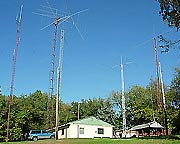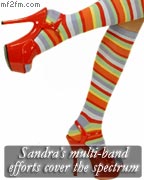Thursday 7 September, 2006, 08:44 - Amateur Radio
Posted by Administrator
With apologies to anyone who may be offended: radio amateurs tend to be a tight-fisted bunch. Often this attitude perpetrates from having other priorities in life (family, holidays, beer etc); sometimes it stems from wishing to prove the age-old maxim 'any fool can do for a pound, what a good engineer can do for a penny'; sometimes it is as a result of having grown up scrimping and saving for the latest hi-spec transistor (which are now available for 5 pence from RadioShack); and sometimes, to be fair, it's just because they don't have much money.Posted by Administrator
However, it's equally fair to say that radio amateurs tend to be very ingenious. They have often been at the forefront of the development of new radio technologies, and even today, when technology has massively overtaken the capability of most amateurs, they still find clever solutions to a range of radio problems.
 One problem which amateurs have been finding solutions to for years, is the problem of installing a single aerial which can cover the wide range of frequencies which hams are allocated, specifically the HF (high frequency) bands, sometimes called short-wave (SW). Prior to the World Administrative Radio Conference in 1979 (WARC-79), the amateur HF bands were at frequencies of 1.8, 3.5, 7, 14, 21 and 28 MHz. Having a single antenna which can work on all these bands would be great:
One problem which amateurs have been finding solutions to for years, is the problem of installing a single aerial which can cover the wide range of frequencies which hams are allocated, specifically the HF (high frequency) bands, sometimes called short-wave (SW). Prior to the World Administrative Radio Conference in 1979 (WARC-79), the amateur HF bands were at frequencies of 1.8, 3.5, 7, 14, 21 and 28 MHz. Having a single antenna which can work on all these bands would be great:- it would be really cheap compared to lots of individual antennas; and
- it would save the back garden from looking like an antenna farm.
Now the scholars amongst you will notice that many of these bands are harmonically related, that is to say that they are multiples of each other: 1.8 times 2 equals 3.6. 7 times 2 equals 14. 7 times 3 equals 21. 14 times 2 equals 28 and so on. Indeed if you start with a frequency of 1.75 MHz (just below 1.8 MHz), there are harmonics at 3.5, 7, 14, 21 and 28 MHz, covering all the bands. Is this fact of any use? Yes it is! An antenna that is 1 wavelength long at 1.75 MHz, will be 2 wavelengths long at 3.5 MHz, 4 wavelengths long at 7 MHz and so on. And, the centre feed point impedance of an antenna that is an exact integer multiple of 1 wavelength is always the same, at around 5000 Ohms. So if we use a broadband transformer capable of converting a 5000 Ohm impedance to that of our transmitter (typically 50 Ohm) a 1 wavelength long antenna at 1.75 MHz will work perfectly well on all these bands. However, It would be 171 metres (or 562 feet) long - not exactly practical (a version with the lowest frequency of 3.5 MHz would still be 86 metres or 281 feet long). Nor is it that easy to produce a broadband transformer that can effect such a drastic change in impedance over such a wide range of frequencies.
 One antenna which aims to address this problem using a little less wire is the G5RV. This is a centre-fed half-wave antenna which, by using an open-wire feeder manages to transform the feed impedance of the antenna on multiple bands to close to the 50 Ohms we require for our transmitter. A G5RV cut for operation on all (pre-WARC 79) bands from 3.5 to 28 MHz is just 31 metres (102 feet) long, a vast improvement in space on our theoretical antenna above.
One antenna which aims to address this problem using a little less wire is the G5RV. This is a centre-fed half-wave antenna which, by using an open-wire feeder manages to transform the feed impedance of the antenna on multiple bands to close to the 50 Ohms we require for our transmitter. A G5RV cut for operation on all (pre-WARC 79) bands from 3.5 to 28 MHz is just 31 metres (102 feet) long, a vast improvement in space on our theoretical antenna above.Another multi-band antenna is the W3DZZ. This 33 metre (108 feet) long antenna uses the fact that a trap represents an inductor below its resonant frequency and a capacitor above it. By carefully choosing the value of the inductor and capacitor in the trap, the antenna can be made to resonate on a number of bands, being an odd multiple of a half wavelength on each (and thus having the same feed impedance).
But: this isn't the end of the problem as, in 1979, along come three new HF amateur bands (10.1, 18.1 and 24.9 MHz)none of which are harmonically related to either 1.8 or 3.5 MHz. Whilst a good antenna tuning unit (ATU) used with a G5RV will allow a reasonable match on these new bands, and the W3DZZ covers 24.9 as well as 3.5, 7, 14, 21 and 28 MHz, the happy situation of being able to use a single antenna on all bands without an ATU was no longer with us. Or was it?
As I said before, radio amateurs are a tight-fisted bunch and not wanting to spend money on multiple antennas, they began to search for an all-band no-tuner antenna. The best attempt at this was the ZS6BKW/G0GSF antenna, which is a modified version of the G5RV. This antenna requires no tuner on the 7, 14, 18.1, 24.9 and 28 MHz bands for an antenna that is just 29 metres (93 feet) long, not bad, but still not quite there.
 We turn our attention then, to the Windom antenna, which works on 3.5, 7, 10, 14, 18.1, 24.9 and 28 MHz (and rumours claim, 50 MHz too) with no tuner (some modifications can also make it work on 21 MHz too). What an astonishing feat of modern computer-aided design?! Nope, the Windom actually dates back to 1929.
We turn our attention then, to the Windom antenna, which works on 3.5, 7, 10, 14, 18.1, 24.9 and 28 MHz (and rumours claim, 50 MHz too) with no tuner (some modifications can also make it work on 21 MHz too). What an astonishing feat of modern computer-aided design?! Nope, the Windom actually dates back to 1929.Finally, there's the T2FD. This antenna uses a resistor to absorb some of the power when the antenna is not a particularly good match. It has a very wideband performance, however this is at the cost of low gain at some frequencies. Great for receiving, not so good for transmitting.
So there are some all-band, no-tune antennas, in particular a modified Windom. Which is great, because there's no way most radio hams will pay for anything more complex!
add comment
( 1814 views )
| permalink
| 



 ( 2.9 / 288 )
( 2.9 / 288 )




 ( 2.9 / 288 )
( 2.9 / 288 )

